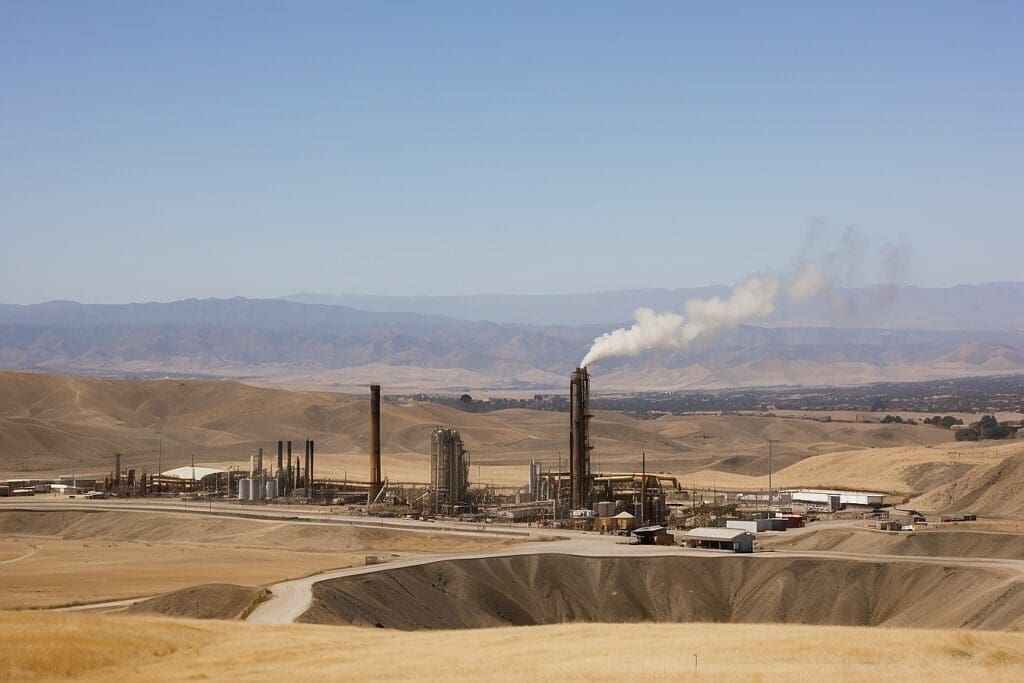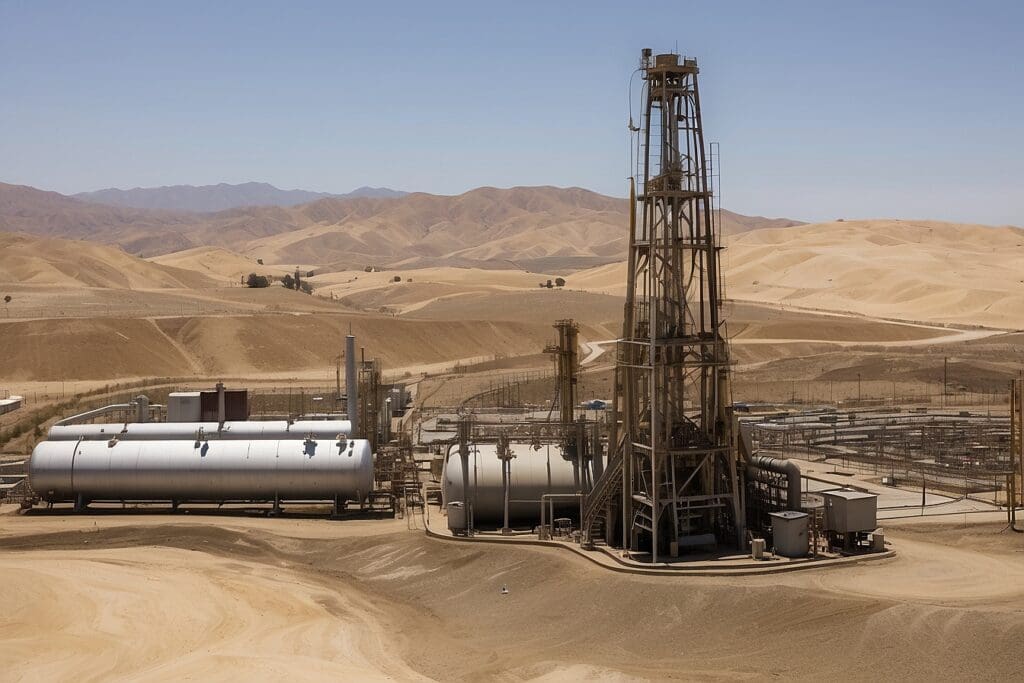The controversial drilling technique of hydraulic fracturing, otherwise known as “fracking,” has created an oil and gas boom across the United States. Many states including New York, Pennsylvania, Colorado, Wyoming and Texas, have all seen heated debates about whether the economic benefits of fracking outweigh the risks to groundwater and public health.1 California, which has long been considered the most environmentally progressive state, may now be joining these others as it wades into the fracking debate. For more detailed background information on fracking, read the section: “The Ugly Side of Natural Gas” in this GreeniacsArticle on the future of natural gas.
California’s Oil and Gas Resources
On December 12, 2012, the federal Bureau of Land Management opened up 18,000 acres of land for oil leases in Monterey, Fresno and San Benito Counties.3 California has always been an oil-producing state, but it’s getting renewed attention because of the Monterey Shale, which is one of the largest shale oil resources in the U.S. The US Energy Information Administration estimates that 15 Billion barrels of oil are still recoverable in the impermeable “tight” rock of California’s Monterey formation. According to a report in Sunday’s New York Times, California contains two-thirds of the U.S.’s shale oil reserves, prompting a land rush to lock up leases for exploratory drilling.4 Indeed, more than 600 wells in at least nine California counties were fracked in 2011 alone. The shale oil reserve stretches under a large part of Central California. In places like Southern Monterey County, where new oil leases are being offered, the battle for fracking is heating up.5
Although oil companies have been aware of the 1,750 square miles of the Monterey Shale crude oil beneath the California surface for decades, until now they have not been able to get to it due to the shale’s complex geological formation. Recently, though, fracking has allowed the oil industry to obtain crude out of increasingly difficult locations.7 Fracking is the process by which: 1) a pressurized mixture of sand, water and chemicals is injected into a horizontally drilled well; 2) the mix cracks the shale and fills the cracks with sandy grit, which allows natural gas to flow up the well; and 3) the recovered water that was used to frack is stored in lined pits or taken to a treatment plant.8
New Regulations and Lawsuit Filed
The potential shale gas rush that has been made possible by hydraulic fracturing has many environmental groups worried. They say that national and state regulations are not strict enough to protect California residents from air, ground water, and other health problems that have plagued states where fracking has already been employed. In a new lawsuit filed by the Center for Biological Diversity in January 2013, the plaintiffs claim that under California’s existing oil and gas regulations, State Regulators have a responsibility to ensure that fracking is conducted in a way that prevents, “as far as possible, damage to life, property and California’s water and other natural resources.”9 In order to comply, future frackers would have to disclose all fracking chemicals (except for those deemed trade secrets), as well as engineering studies and tests to evaluate the potential for underground migration of fracking fluids.10 In addition, in response to growing public concern, state regulators issued a “discussion draft” of new regulations that would cover fracking in December 2012.11 You can find all the material related to these regulations here.

Major Environmental Concerns being Raised against Fracking:
- Climate Change: The fracking process allows drillers to get to natural gas. Fugitive emissions, or byproducts, of this process include methane, which is a potent renewable energy .12
- Trade secrets: Companies are required to disclose what they’re injecting into the ground when they frack. This disclosure usually includes chemicals such as diesel compounds and known carcinogens, unless the companies claim a “trade secret” exemption. Under this exemption, companies only have to disclose what family the injected chemicals are from. Critics say this is a loophole. Concerned groups in Texas, for example, point out that the trade secret rule has become overused, as it has been cited 19,000 times.13
- Disclosure to FracFocus: The new state regulations require that oil and gas companies disclose all chemicals used in the fracking process within 60 days after the completion of fracking and that the state be notified 10 days before fracking occurs. This is a step forward given that energy producers currently aren’t required to tell anyone where or when they’re using hydraulic fracturing. The problem is that: 1) by the time the 60 days are up, the frack job is already complete; and 2) disclosure is currently done only through the industry-run site www.FracFocus.org and companies do not have to notify nearby landowners. Some environmentalists have questioned whether or not it is a good idea to rely on a private, industry-run website to host this information, especially when the site isn’t required to comply with Freedom of Information Act requests.14
- Earthquakes: A recent earthquake in Oklahoma has led to concerns that fracking can cause earthquakes.15 Fortunately, California geologists calculate that the risk of a big earthquake from fracking itself is relatively low. That doesn’t mean that earthquakes are no concern at all though. Fracking wastewater is often disposed of by injecting it underground, which builds up pressure. A large earthquake could cause this wastewater to migrate into nearby aquifers. Mark Zoback, a geophysicist at Stanford University, told reporters that the state is going to need to increase its scrutiny of wastewater rules: “California’s geology is so complex… that safety has to be considered on a site by site basis.”16
- Water: Most Californians are familiar with Mark Twain’s famous line, “whiskey is for drinking, water is for fighting over.” California, and particularly the southern half of California, is already quite water starved. This makes many environmentalists wary of a process where an average well may require up to an additional 5 million gallons of water over its lifetime.17 A cumulative 2.8 trillion gallons of water has been used for fracking in California to date. This water is almost exclusively taken from the endangered Sacramento/San Joaquin Delta estuary , which is home to several species of endangered Northern California fish. State Senator Lois Wolk (D-Davis) told the California Progress Report that “Our groundwater resources need to be protected from oil and gas development.” He wants to be sure that Californians know just how much water is being used for fracking purposes, given the state’s limited supply.18
There’s no question that shale gas represents a big economic opportunity for this country and has created a lot of jobs. It is also true that replacing coal with cleaner natural gas can help in the transition to a renewable energy economy. The question is whether or not California will be able to make hydraulic fracturing safe. The public will have a chance to comment on the proposed rules. For more information, check out: hinsongravelle.com/upcoming-hearings-on-californias-proposed-fracking-regulations.


